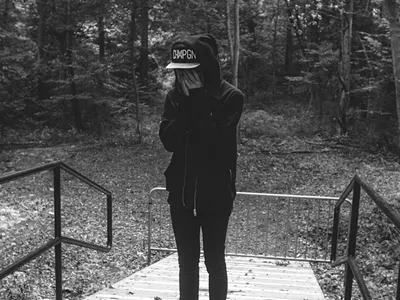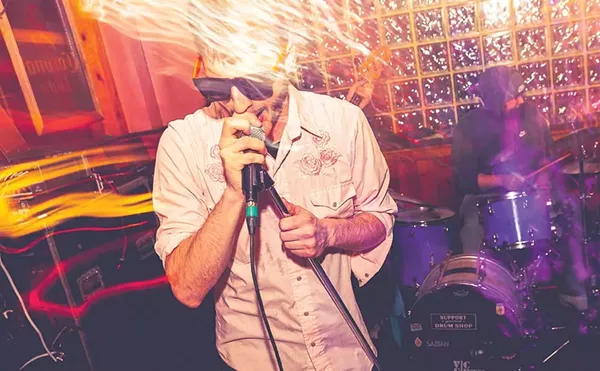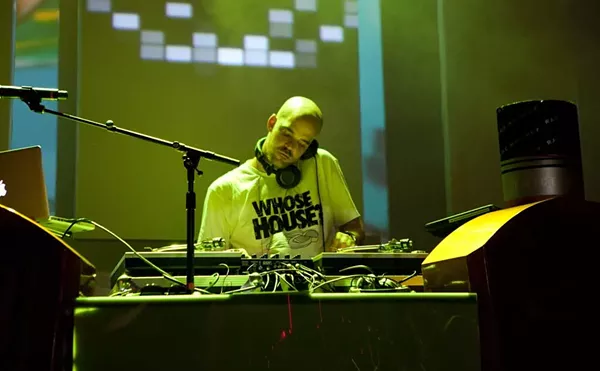Detroit, in spite of all its groundbreaking and trendsetting, is riddled with problems. Sometimes it feels like the only thing that the troubled city has more of than problems is punks.
But really — what is a punk? Especially when it comes to the city that has proudly brought you, among other things, the motor car manufacturing process refined, unforgettable music and most notably the do-or-die spirit that is the only thing that can logically explain how an increasingly dwindling population refuses to take no for an answer.
"Really, I think someone else should do it right now. We're not going to make money. We don't have any fucking time... The fact is, nobody else is doing it."
That's what Ivan Suvanjieff has to say about a documentary project dealing directly with the topic — at least musically — called Detroit Punks. Since 1978, he's been setting up serial interview sessions in some of the seediest motels in town in order to shed light on what it is that makes the punk music scene in Detroit keep ticking, past and present.
Roomfuls of footage have been recorded with just about anyone you could imagine that's touched the scene. But so far, just two documentaries have been released in the series; the first on John Brannon (Negative Approach, Laughing Hyenas, Easy Action), and the second on the Gories. The third installment will feature none other than Orbit's founder and lovable misfit, Jerry Vile (the Boners and artist-at-large). Mum's the word on future editions, but you can be certain each one will be filled with candid and sordid details.
Suvanjieff has a unique perspective on the whole thing, as both an active member of the scene and as an observer. In a sort-of former life, Suvanjieff was known as Mark J. Norton, an associate editor for the legendary off-the-cuff music rag CREEM from the 1970s and 1980s. He was the voice of the Ramrods, whose intense burst of energy in the late 1970s could only endure the span of about one year, in true punk form. He is also a painter of the abstract variety who renders his visions solely in black and white. These days, he spends most of his time working with Nobel Peace Prize laureates with his wife and partner in crime, Dawn Gifford Engle.
The couple, now based out of Colorado, are proud to share their Detroit upbringing and unique perspective with just about anyone they meet. They affectionately refer to their higher-profile project, the PeaceJam Foundation, as their "day job." And it has gained international appeal, finding them traveling the world and communing regularly with the likes of the Dalai Lama, South African social rights activist Desmond Tutu — and likely anyone who's gained notoriety in the very idea of peace.
Peace and punks.
The two ideas might seem opposing until you recall those words of fury and wisdom uttered by Rev. J. C. Crawford, MC of the MC5 and pastor of the Zenta religion, at the Grande Ballroom on that oft-recalled late October night in 1968. As the show opens, Crawford poses a challenge to his audience: "Brothers and sisters, the time has come for each and every one of you to decide whether you are gonna be the problem or whether you are gonna be the solution." Then the MC5 speed off into "Ramblin' Rose," the anthem that somehow unfairly lags in the shadows of the more raucous "Kick Out the Jams" (you know what).
Yes, peace. And yes, punks. Perhaps the goal of anarchy really is peace, after all.
Engle has a history as an economist, at one time holding court in the U.S. Congress in Washington, D.C. Having mastered a firm footing in politics in order to use them to her desired end, she's collected numerous accolades for her work toward activism. Since the mid-1990s, both Engle and Suvanjieff have been working together to enlist peaceful acts on an international, grass-roots level that has earned them Nobel Peace Prize nominations several times over. Perhaps their latest nomination surrounding their One Billion Acts of Peace campaign will land them the prize.
Engle emphasizes their different approach used in the goal of achieving peace. "When we first meet the Nobel Peace Prize winners, we let them know that Ivan is a rocker from the Ramrods, sometimes even wearing his leather jacket. [We are] the punk rocker and the economist — and they love that. They know when they sign up that it is because it's done in this new way, this kind of Detroit grassroots gritty kind of way and that it is going to work."
Grittiness seems to work well for Detroit Punks too, which is highlighted by their distinct black and white presentation.
"The most iconic photographs I've ever seen are in black and white. I've been painting in black and white for 25 fucking years. I just like the stripped-down look," says Suvanjieff from his home nestled in between a peaceful scenic stream and the foothills of Colorado.
From their Colorado PeaceJam headquarters, the dynamic duo take their massive footage and clear vision to collaborate with Zabe Halloway (director and editor, John Brannon; co-editor, the Gories) and William Elder (co-editor, the Gories) to create the series which has already received industry recognition for its refreshingly no-nonsense, fact-not-fiction approach.
It happens to be the same approach they keep for PeaceJam projects. "In 2014," notes Suvanjieff, "we did a documentary for PeaceJam about Desmond Tutu and another documentary for Detroit Punks about John Brannon. I think they call surrealism the juxtaposition of opposing realities, and that would be one of them. But you cannot say that that's apples and oranges. No, it's not. It's a funny thing that human beings are human beings, and John Brannon is just as frail as Desmond Tutu is."
"Frail" is not the first quality to come to mind when considering Brannon, whose voice alone could bowl you over all the way from the back of the room. But at the right angle, in both the Brannon and the Gories documentaries, new elements of the humanity behind the fight become evident. Suddenly, we realize that, like all of Detroit's problems, the solutions may have been lurking beneath the surface all along. We've just forgotten to give a careful listen to the noise.
The first two Detroit Punks documentaries, along with weekly vignettes featuring interviews along the way, can be found online and viewed by anyone with a computer at detroitpunks.com. Don't forget, it's not Orby's fault you gave your kid an iPad.
Liz Warner, AKA Liz Copeland, Zotik, Colin Webcott, and any other number of names, is somehow a master at becoming part of the solution while simultaneously becoming part of the problem. Who likes playing favorites, anyway?








